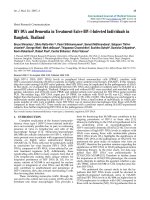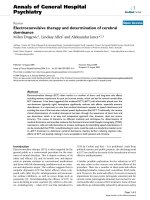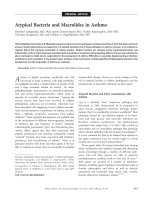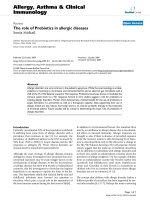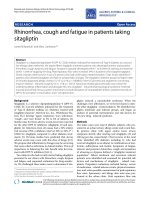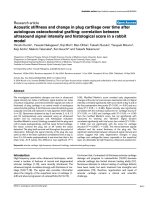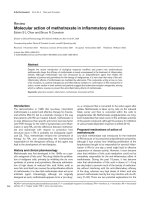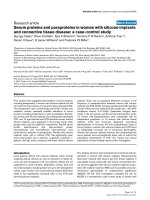Báo cáo y học: " HIV-2 diagnosis and quantification in high-risk patients" ppt
Bạn đang xem bản rút gọn của tài liệu. Xem và tải ngay bản đầy đủ của tài liệu tại đây (244.49 KB, 5 trang )
BioMed Central
Page 1 of 5
(page number not for citation purposes)
AIDS Research and Therapy
Open Access
Case report
HIV-2 diagnosis and quantification in high-risk patients
Philip A Chan*
1
, Sarah E Wakeman
1
, Timothy Flanigan
2
, Susan Cu-Uvin
2
,
Erna Kojic
2
and Rami Kantor
2
Address:
1
Department of Internal Medicine, The Warren Alpert Medical School of Brown, University and Rhode Island Hospital, Providence, RI
02903, USA and
2
Division of Infectious Disease, The Warren Alpert Medical School of Brown University and The Miriam Hospital, Providence, RI
02906, USA
Email: Philip A Chan* - ; Sarah E Wakeman - ; Timothy Flanigan - ;
Susan Cu-Uvin - ; Erna Kojic - ; Rami Kantor -
* Corresponding author
Abstract
Current diagnostic assays for HIV-1 do not always test for the presence of HIV-2 in the United
States. We present the case of a patient from Cape Verde, who was admitted to our hospital with
rapidly deteriorating neurological function and multiple white matter lesions on MRI likely
secondary to progressive multifocal leukoencephalopathy (PML). Initially, the patient had a positive
EIA for HIV, but a negative HIV-1 Western Blot and no viral load detected on a branched-DNA
assay. A repeat viral load by reverse transcriptase methodology (RT-DNA) detected 121,000
copies and an HIV-2 Western Blot was positive. The case highlights an extremely rare presentation
of HIV-2 with severe neurological disease. We discuss the different tests available for the diagnosis
and monitoring of HIV-2 in the United States.
Background
HIV-2, the second AIDS-causing virus, is found predomi-
nantly in the Portuguese speaking countries of West
Africa, with the highest rates of infection in Guinea-Bissau
[1]. The prevalence of HIV-2 in the United States is
extremely low [2], and the current guidelines recommend
testing for HIV-2 only in the case of an indeterminate
western blot or in patients with known links to West
Africa [2,3]. While this screening practice may make sense
for the majority of U.S. cities where the percentage of the
population of West African descent is decidedly small, cit-
ies with a significant immigrant community from infected
regions should consider increased surveillance. We
present the case of a patient of Cape Verdean descent with
likely PML in the setting of HIV-2, and discuss the difficul-
ties of diagnosing HIV-2 in the United States.
Case presentation
A 48 year-old male with a past medical history significant
only for cataracts was admitted to our hospital with weak-
ness, difficulty walking, and confusion that began one day
prior to admission. In addition to the neurological symp-
toms, the patient had experienced a flu-like illness three to
four weeks earlier accompanied by a ten to fifteen pound
weight loss. The patient was afebrile with mental status
changes and abnormal cerebellar findings on neurologi-
cal exam including a wide-based gait, ataxia, dysmetria on
finger-to-nose, and difficulty with rapid alternating hand
movements. On further history, the patient took no med-
ications and was born in Cape Verde, immigrating to the
United States six years earlier. While he admitted to hav-
ing multiple recent female sexual partners, he denied any
drug use or any male sexual partners. His wife and five
Published: 14 August 2008
AIDS Research and Therapy 2008, 5:18 doi:10.1186/1742-6405-5-18
Received: 3 July 2008
Accepted: 14 August 2008
This article is available from: />© 2008 Chan et al; licensee BioMed Central Ltd.
This is an Open Access article distributed under the terms of the Creative Commons Attribution License ( />),
which permits unrestricted use, distribution, and reproduction in any medium, provided the original work is properly cited.
AIDS Research and Therapy 2008, 5:18 />Page 2 of 5
(page number not for citation purposes)
children remained in Cape Verde. His history raised the
possibility of acute HIV infection or an AIDS-related ill-
ness.
An initial HIV enzyme immunoassay (EIA) was per-
formed in the emergency room and returned positive
(Bayer ADVIA Centaur HIV-1/O/2 EHIV EIA). Other labo-
ratory tests were normal, aside from a slightly decreased
white count of 3,800 cells/uL. A non-contrast CT of the
brain on admission noted no acute abnormalities. An
MRI with and without contrast of the brain was per-
formed on the second day of admission, which showed
multifocal supra and infratentorial T2 flare hyperintense
lesions felt to be consistent with multiple sclerosis, an
acute demyelinating process, or Lyme disease. Two lum-
bar punctures were subsequently performed showing four
nucleated cells, an elevated protein of 103 mg/dL, and a
normal glucose. Testing of the cerebrospinal fluid (CSF)
was negative for cytomegalovirus (CMV, PCR), Epstein-
Barr Virus (EBV, PCR), varicella zoster virus (VZV, PCR),
Lyme (IgM and IgG antibodies, PCR), herpes simplex
virus (HSV-1 and -2, IgM and IgG antibodies), Toxoplas-
mosis (IgM and IgG antibodies), India Ink, Cryptococcal
antigen, Streptococcal antigen, rapid plasma reagin
(RPR), JC Virus (PCR), acid-fast bacilli (AFB), and cytol-
ogy. Other labs sent for the evaluation of mental status
change were normal including electrolytes, B12, TSH, and
a urine drug screen. Serum tests looking for an infectious
etiology were also negative, including an RPR, fluorescent
treponemal antibody (FTA-ABS), CMV antibodies, and
Lyme antibodies. A hepatitis panel revealed past infec-
tions with hepatitis A and B, and a negative hepatitis C
antibody. Blood, urine, and CSF cultures were negative, as
was a rapid influenza. The patient's CD4 count returned at
202 (17%, ratio 0.3).
The patient improved with supportive care over the hospi-
tal course and was discharged on day five with follow-up
to an outpatient clinic. Six days later the patient was seen
at HIV clinic, at which point his confirmatory western blot
for HIV-1 was still pending. Based on the patient's clinical
history, CD4 count, positive EIA, and recent immigration
from Western Africa, it was felt that the patient was most
likely suffering from an HIV-related neurological process.
He was started on the anti-retroviral regimen of ritonavir-
boosted atazanavir (ATV), tenofovir (TDF), and emtricit-
abine (FTC), and a plasma viral load was sent.
Six days after the clinic visit, the patient was readmitted to
the hospital for continued confusion and gait disturbance.
The patient's initial confirmatory western blot for HIV-1
returned negative and the viral load was undetectable
(branched DNA technology, Versant HIV-1 RNA 3.0,
Bayer). Given the confusing picture and strong clinical
suspicion for HIV, a second Western blot specific for HIV-
2 was sent, as well as a repeat viral load using RT-PCR
analysis (Roche Amplicor RT-PCR). The patient had a
repeat MRI which showed interval worsening of the white
matter lesions, but no new processes. During the course of
this hospitalization, the patient's second viral load
returned at 121,000 copies/mL and the western blot was
positive for HIV-2. The differential diagnosis based on the
patient's clinical history and imaging included PML, HIV
encephalitis and/or lymphoma. Given the patient's nega-
tive CSF EBV and disseminated (non-solitary) MRI
lesions, it was deemed highly unlikely that the patient had
CNS Lymphoma. Although the patient had a negative JC
virus PCR, review of the MRI found the lesions to be most
consistent with PML and/or HIV encephalitis. A brain
biopsy was considered, but the patient and his family
refused.
Looking back over the hospital's records, it was discovered
that the patient had been seen two years prior to this
admission for a unilateral facial droop. In addition, a
steadily declining WBC count was noted through several
emergency room visits. Based on these findings, as well as
the clinical presentation, the patient was felt to have
chronic, as opposed to acute, HIV-2. While the patient
may have had sexual contact with other West African
immigrants in this country, it seemed most likely that he
had become infected while living in Cape Verde more
than six years earlier.
Over the first week of the second admission, the patient
worsened neurologically, becoming incontinent and
acutely agitated requiring medication with anti-psychot-
ics. A repeat MRI of the brain on day eight of admission
showed rapid progression of the white matter disease, as
described above. Given the patient's poor prognosis, hos-
pice was considered. The patient was changed to ritonavir-
boosted lopinavir, and over the next couple weeks made
significant clinical improvements, regaining continence,
becoming increasingly lucid, and improving in gait and
balance. By the fourth week of his admission, his CD4
count had increased to 331 (17.4%), although his MRI
showed no regression of the lesions. The patient was dis-
charged on HAART in stable condition, but with persist-
ent neurological deficits.
Discussion
We present a case report of an unusual and challenging
diagnosis of HIV-2 in the United States. Our patient emi-
grated from Cape Verde, an archipelago off the west coast
of Africa with an estimated population of 460,000. Cape
Verde is a place defined by migration, with approximately
500,000 people living abroad, 265,000 of which are esti-
mated to be in the United States [4]. The migration of
Cape Verdeans to the United States began in the 1800's
with whaling ships that carried West Africans to New Eng-
AIDS Research and Therapy 2008, 5:18 />Page 3 of 5
(page number not for citation purposes)
land's shores. New Bedford, Massachusetts and Provi-
dence, Rhode Island are America's oldest Cape Verdean
communities, with 1,592 legal immigrants settling in the
Providence Metro area between 1991 and 1998 alone [5].
The prevalence of non-subtype B HIV in the United States
is approximately 2% [6]. The virus isolated in this patient,
HIV-2, is common in parts of Western Africa, but is rare in
the United States [7]. HIV-2 is thought to have a milder
disease course with a longer time to the development of
AIDS than HIV-1 [8,9]. Clinical presentations of neuro-
logical syndromes with HIV-2 are extremely rare [10,11].
Since being discovered in 1985 [12], only 79 cases of HIV-
2 have been reported in the United States with 52 of those
patients having originated in Western Africa [2]. Given the
low prevalence of HIV-2 in industrialized countries, the
clinical course and optimal treatment strategies are
unknown [12]. Non-nucleoside reverse transciptase
inhibitors (NNRTI's) are not effective against HIV-2,
whereas nucleoside reverse transciptase inhibitors
(NRTI's) may be less effective [13,14]. Protease inhibitors
have varying efficacy against HIV-2 [15-18] and use
should be guided by genotype/phenotype profiles, not
commercially available in the United States. Ritonavir-
boosted atazanavir was initially started in this patient
before the diagnosis of HIV-2, but was later changed to
ritonavir-boosted lopinavir which has better efficacy
against HIV-2 [16].
The identification of HIV-2 represents a diagnostic
dilemma in the United States. The standard diagnosis of
HIV-1 infection relies on a positive EIA followed by a con-
firmatory western blot assay in which two of the three HIV
antigens (p24, gp41, and gp120) must be present. Screen-
ing EIA assays, including the newer rapid tests, are not
always sensitive for detecting HIV-2 or group O HIV-1
[19-22], however the newer 4
th
generation assays are bet-
ter [5,23-25]. Routine western blots are specific mainly for
HIV-1 antibodies and indeterminate western blots (i.e.
detection of only one antigen, usually p24) may suggest
infection with HIV-2. The only FDA-approved EIA assays
that are able to detect HIV-2 are Abbott HIVAB HIV-1/2
(rDNA) EIA, Genetic Systems HIV-1/2 Peptide EIA, and
Genetic Systems HIV-2 EIA.
Current CDC guidelines [26] state that HIV-2 serology
should be checked in patients who: 1) Are from areas of
high prevalence, mainly Western Africa; 2) Share needles
or have sexual partners known to be infected with HIV-2
or are from endemic areas; 3) Received transfusions or
other non-sterile medical care from endemic areas; 4) Are
children of women with risk factors for HIV-2 infection.
As sometimes clinical history is not available in patients
with a high-suspicion for HIV infection and negative or
indeterminate serology for HIV-1, additional testing
should be performed for HIV-2.
Regarding viral RNA quantification, there are no FDA
approved assays for the determination of HIV-2 viral load
in the United States (Table 1). This creates a dilemma in
the treatment of HIV-2 infected patients as viral loads are
an integral part of patient monitoring. The five methods
for detecting viral loads all routinely detect HIV-1 viral
RNA from most group M subtypes, although small differ-
ences may exist in quantification capabilities [27-32].
Assays for HIV-2 are mainly developed for research pur-
poses and none are commercially available [15,28,33-35].
The NucliSens EasyQ assay (BioMerieux, Netherlands) is
approved for HIV-1 viral load quantification and has been
shown to detect subtype A of HIV-2 by nucleic acid ampli-
fication [36]. Similarly, the Roche Amplicor assay was
able to detect three of four HIV-2 samples [37]. Neither
the branched DNA nor other RT-PCR assays have been
shown to detect HIV-2, and none are approved by the FDA
or regularly used to detect HIV-2. Differences between the
assays are likely due to primers which are more likely to
anneal and be specific to certain areas of both HIV-1 and
HIV-2 depending on target sequences. Further studies are
needed to define the sensitivity and specificity of these
tests' ability to detect HIV-2.
Table 1: FDA approved assays for the quantification of HIV RNA
Assay Manufacturer Technique Sensitivity (copies/ml) HIV-1 Subtypes HIV-2
AMPLICOR [39,40] Roche RT-PCR 50
†
-750,000 Group M (subtypes A-H) Detected 3/4 HIV-2 [37]
Versant HIV-1 RNA 3.0 [41] Bayer bDNA 75–500,000 Group M (subtypes A-G) No [42]
NucliSens HIV RNA QT
[28,43]
BioMereiux NASBA 176–3.4 million Group M (not subtype G) YES [36] (subtype A)
COBAS AmpliPrep, Taqman
HIV-1 [44]
Roche RT-PCR 48–10 million Group M (subtypes A-H) No [3,45]
RealTime HIV-1 [45] Abbott RT-PCR 40–10 million Group M, N, O,
recombinants
No [45]
NASBA: Nucleic acid sequence based amplification assay
RT-PCR: Reverse transcription polymerase-chain reaction
bDNA: Branched DNA assay
†
The standard assay can detect 400–750,000 copies/ml and the ultra-sensitive assay can detect 50–100,000 copies/ml.
AIDS Research and Therapy 2008, 5:18 />Page 4 of 5
(page number not for citation purposes)
In our institution, patients are tested for HIV using the
Bayer ADVIA Centaur HIV-1/O/2 EHIV EIA [38]. This was
positive in our patient, but a western blot for HIV-1 was
negative. The Versant branched DNA assay is our standard
measure for HIV viral loads, but this technique did not
quantify any viral RNA in this particular patient. Follow-
up testing with a western blot specific for HIV-2 was posi-
tive and subsequent viral quantification based the Roche
Amplicor system showed a significant viral load.
Our patient exemplifies the diagnostic difficulties of iden-
tifying HIV-2 in the United States. Fortunately, we were
able to elucidate a history of Western African origin from
our patient. All physicians involved in screening for HIV
should be aware of the limitations between assays and
know which test their institution uses. Clinicians need to
have a high index of suspicion in patients with risk factors
for HIV-2 to appropriately diagnose and treat the disease.
Competing interests
SC reports receiving grant support for an unrelated study
from Bristol-Myers Squibb. All other authors declare there
are no competing interests in this work. The present study
was unfunded.
Authors' contributions
PC and SW participated in the research, writing, and edit-
ing of the manuscript. TF, SC, EK, and RK participated in
the writing and editing of the manuscript. All authors read
and approved the final manuscript.
References
1. Schmidt WP, Schim VANDERLM, Aaby P, Whittle H, Bakker R, Buck-
ner M, Dias F, White RG: Behaviour change and competitive
exclusion can explain the diverging HIV-1 and HIV-2 preva-
lence trends in Guinea-Bissau. Epidemiol Infect 2008,
136(4):551-561.
2. Factsheet C: 1998 [ />hiv2.htm].
3. Owen SM, Yang C, Spira T, Ou CY, Pau CP, Parekh BS, Candal D,
Kuehl D, Kennedy MS, Rudolph D, Luo W, Delatorre N, Masciotra S,
Kalish ML, Cowart F, Barnett T, Lal R, McDougal JS: Alternative
Algorithms for HIV Diagnosis Using Tests that are Licensed
in the United States. J Clin Microbiol 2008.
4. DeParle J: In a World on the Move, a Tiny Land Strains to
Cope. The New York Times; 2007.
5. Federation for American Immigration Reform [http:www.fai-
rus.org/site/PageS
erver?pagename=research_research9f8b_sup#legal]
6. Delwart EL, Orton S, Parekh B, Dobbs T, Clark K, Busch MP: Two
percent of HIV-positive U.S. blood donors are infected with
non-subtype B strains. AIDS Res Hum Retroviruses 2003,
19(12):1065-1070.
7. Loeff MF Schim van der, Aaby P: Towards a better understanding
of the epidemiology of HIV-2. Aids 1999, 13(Suppl A):S69-84.
8. Kanki PJ, Travers KU, S MB, Hsieh CC, Marlink RG, Gueye NA, Siby
T, Thior I, Hernandez-Avila M, Sankale JL: Slower heterosexual
spread of HIV-2 than HIV-1. Lancet 1994, 343(8903):943-946.
9. Marlink R, Kanki P, Thior I, Travers K, Eisen G, Siby T, Traore I, Hsieh
CC, Dia MC, Gueye EH: Reduced rate of disease development
after HIV-2 infection as compared to HIV-1. Science 1994,
265(5178):1587-1590.
10. Bienaime A, Colson P, Moreau J, Zandotti C, Pellissier JF, Brouqui P:
Progressive multifocal leukoencephalopathy in HIV-2-
infected patient. Aids 2006, 20(9):1342-1343.
11. Moulignier A, Lascoux C, Bourgarit A: HIV type 2 demyelinating
encephalomyelitis. Clin Infect Dis 2006, 42(11):e89-91.
12. Kanki PJ, Barin F, M'Boup S, Allan JS, Romet-Lemonne JL, Marlink R,
McLane MF, Lee TH, Arbeille B, Denis F: New human T-lympho-
tropic retrovirus related to simian T-lymphotropic virus
type III (STLV-IIIAGM). Science 1986, 232(4747):238-243.
13. Ren J, Bird LE, Chamberlain PP, Stewart-Jones GB, Stuart DI, Stam-
mers DK: Structure of HIV-2 reverse transcriptase at 2.35-A
resolution and the mechanism of resistance to non-nucleo-
side inhibitors. Proc Natl Acad Sci USA 2002, 99(22):14410-14415.
14. Witvrouw M, Pannecouque C, Switzer WM, Folks TM, De Clercq E,
Heneine W: Susceptibility of HIV-2, SIV and SHIV to various
anti-HIV-1 compounds: implications for treatment and pos-
texposure prophylaxis. Antivir Ther 2004, 9(1):57-65.
15. Adje-Toure CA, Cheingsong R, Garcia-Lerma JG, Eholie S, Borget
MY, Bouchez JM, Otten RA, Maurice C, Sassan-Morokro M, Ekpini RE,
Nolan M, Chorba T, Heneine W, Nkengasong JN: Antiretroviral
therapy in HIV-2-infected patients: changes in plasma viral
load, CD4+ cell counts, and drug resistance profiles of
patients treated in Abidjan, Cote d'Ivoire.
Aids 2003, 17(Suppl
3):S49-54.
16. Desbois D, Roquebert B, Peytavin G, Damond F, Collin G, Benard A,
Campa P, Matheron S, Chene G, Brun-Vezinet F, Descamps D: In
vitro phenotypic susceptibility of human immunodeficiency
virus type 2 clinical isolates to protease inhibitors. Antimicrob
Agents Chemother 2008, 52(4):1545-1548.
17. Ntemgwa M, Brenner BG, Oliveira M, Moisi D, Wainberg MA: Nat-
ural polymorphisms in the human immunodeficiency virus
type 2 protease can accelerate time to development of
resistance to protease inhibitors. Antimicrob Agents Chemother
2007, 51(2):604-610.
18. Rodes B, Sheldon J, Toro C, Jimenez V, Alvarez MA, Soriano V: Sus-
ceptibility to protease inhibitors in HIV-2 primary isolates
from patients failing antiretroviral therapy. J Antimicrob Chem-
other 2006, 57(4):709-713.
19. Identification of HIV-1 group O infection – Los Angeles
county, California, 1996. MMWR Morb Mortal Wkly Rep 1996,
45(26):561-565.
20. Loussert-Ajaka I, Ly TD, Chaix ML, Ingrand D, Saragosti S, Courouce
AM, Brun-Vezinet F, Simon F: HIV-1/HIV-2 seronegativity in
HIV-1 subtype O infected patients. Lancet 1994,
343(8910):1393-1394.
21. Schable C, Zekeng L, Pau CP, Hu D, Kaptue L, Gurtler L, Dondero T,
Tsague JM, Schochetman G, Jaffe H: Sensitivity of United States
HIV antibody tests for detection of HIV-1 group O infections.
Lancet 1994, 344(8933):1333-1334.
22. Zouhair S, Roussin-Bretagne S, Moreau A, Brunet S, Laperche S,
Maniez M, Barin F, Harzic M: Group o human immunodeficiency
virus type 1 infection that escaped detection in two immmu-
noassays. J Clin Microbiol 2006, 44(2):662-665.
23. Saville RD, Constantine NT, Cleghorn FR, Jack N, Bartholomew C,
Edwards J, Gomez P, Blattner WA: Fourth-generation enzyme-
linked immunosorbent assay for the simultaneous detection
of human immunodeficiency virus antigen and antibody. J
Clin Microbiol 2001, 39(7):2518-2524.
24. Weber B, Orazi B, Raineri A, Thorstensson R, Burgisser P, Muhl-
bacher A, Areal C, Eiras A, Villaescusa R, Camacho R, Diogo I, Roth
HJ, Zahn I, Bartel J, Bossi V, Piro F, Atamasirikul K, Permpikul P, Web-
ber L, Singh S:
Multicenter evaluation of a new 4th generation
HIV screening assay Elecsys HIV combi. Clin Lab 2006,
52(9–10):463-473.
25. Yeom JS, Jun G, Chang Y, Sohn MJ, Yoo S, Kim E, Ryu SH, Kang HJ,
Kim YA, Ahn SY, Cha JE, Youn ST, Park JW: Evaluation of a new
fourth generation enzyme-linked immunosorbent assay, the
LG HIV Ag-Ab Plus, with a combined HIV p24 antigen and
anti-HIV-1/2/O screening test. J Virol Methods 2006,
137(2):292-297.
26. O'Brien TR, George JR, Epstein JS, Holmberg SD, Schochetman G:
Testing for antibodies to human immunodeficiency virus
type 2 in the United States. MMWR Recomm Rep 1992, 41(RR-
12):1-9.
27. Braun P, Ehret R, Wiesmann F, Zabbai F, Knickmann M, Kuhn R,
Thamm S, Warnat G, Knechten H: Comparison of four commer-
Publish with BioMed Central and every
scientist can read your work free of charge
"BioMed Central will be the most significant development for
disseminating the results of biomedical research in our lifetime."
Sir Paul Nurse, Cancer Research UK
Your research papers will be:
available free of charge to the entire biomedical community
peer reviewed and published immediately upon acceptance
cited in PubMed and archived on PubMed Central
yours — you keep the copyright
Submit your manuscript here:
/>BioMedcentral
AIDS Research and Therapy 2008, 5:18 />Page 5 of 5
(page number not for citation purposes)
cial quantitative HIV-1 assays for viral load monitoring in
clinical daily routine. Clin Chem Lab Med 2007, 45(1):93-99.
28. Damond F, Gueudin M, Pueyo S, Farfara I, Robertson DL, Descamps
D, Chene G, Matheron S, Campa P, Brun-Vezinet F, Simon F: Plasma
RNA viral load in human immunodeficiency virus type 2 sub-
type A and subtype B infections. J Clin Microbiol 2002,
40(10):3654-3659.
29. Elbeik T, Alvord WG, Trichavaroj R, de Souza M, Dewar R, Brown A,
Chernoff D, Michael NL, Nassos P, Hadley K, Ng VL: Comparative
analysis of HIV-1 viral load assays on subtype quantification:
Bayer Versant HIV-1 RNA 3.0 versus Roche Amplicor HIV-1
Monitor version 1.5. J Acquir Immune Defic Syndr 2002,
29(4):330-339.
30. Galli R, Merrick L, Friesenhahn M, Ziermann R: Comprehensive
comparison of the VERSANT HIV-1 RNA 3.0 (bDNA) and
COBAS AMPLICOR HIV-1 MONITOR 1.5 assays on 1,000
clinical specimens. J Clin Virol 2005, 34(4):245-252.
31. Gleaves CA, Welle J, Campbell M, Elbeik T, Ng V, Taylor PE,
Kuramoto K, Aceituno S, Lewalski E, Joppa B, Sawyer L, Schaper C,
McNairn D, Quinn T: Multicenter evaluation of the Bayer VER-
SANT HIV-1 RNA 3.0 assay: analytical and clinical perform-
ance. J Clin Virol 2002, 25(2):205-216.
32. Gomes P, Palma AC, Cabanas J, Abecasis A, Carvalho AP, Ziermann
R, Diogo I, Goncalves F, Lobo CS, Camacho R: Comparison of the
COBAS TAQMAN HIV-1 HPS with VERSANT HIV-1 RNA
3.0 assay (bDNA) for plasma RNA quantitation in different
HIV-1 subtypes. J Virol Methods 2006, 135(2):223-228.
33. Berry N, Ariyoshi K, Jaffar S, Sabally S, Corrah T, Tedder R, Whittle
H: Low peripheral blood viral HIV-2 RNA in individuals with
high CD4 percentage differentiates HIV-2 from HIV-1 infec-
tion. J Hum Virol 1998, 1(7):457-468.
34. Popper SJ, Sarr AD, Travers KU, Gueye-Ndiaye A, Mboup S, Essex
ME, Kanki PJ: Lower human immunodeficiency virus (HIV)
type 2 viral load reflects the difference in pathogenicity of
HIV-1 and HIV-2. J Infect Dis 1999, 180(4):1116-1121.
35. Ruelle J, Mukadi BK, Schutten M, Goubau P: Quantitative real-
time PCR on Lightcycler for the detection of human immu-
nodeficiency virus type 2 (HIV-2). J Virol Methods 2004,
117(1):67-74.
36. Rodes B, Sheldon J, Toro C, Cuevas L, Perez-Pastrana E, Herrera I,
Soriano V: Quantitative detection of plasma human immuno-
deficiency virus type 2 subtype A RNA by the Nuclisens
EasyQ Assay (version 1.1). J Clin Microbiol 2007, 45(1):88-92.
37. Roche : Summary Insert: AMPLICOR RT-PCR Version 1.5. .
38. Schappert J, Wians FH Jr, Schiff E, Smalley D, Gambardella R, Lee WM,
Wu J, Keiser P, Peterson D, De Medina M, Baker L, Preisel-Simmons
B: Multicenter evaluation of the Bayer ADVIA Centaur HIV
1/O/2 enhanced (EHIV) assay. Clin Chim Acta 2006,
372(1–2):158-166.
39. Mulder J, McKinney N, Christopherson C, Sninsky J, Greenfield L,
Kwok S: Rapid and simple PCR assay for quantitation of
human immunodeficiency virus type 1 RNA in plasma: appli-
cation to acute retroviral infection. J Clin Microbiol 1994,
32(2):292-300.
40. Nolte FS, Boysza J, Thurmond C, Clark WS, Lennox JL: Clinical
comparison of an enhanced-sensitivity branched-DNA assay
and reverse transcription-PCR for quantitation of human
immunodeficiency virus type 1 RNA in plasma. J Clin Microbiol
1998, 36(3):716-720.
41. Pachl C, Todd JA, Kern DG, Sheridan PJ, Fong SJ, Stempien M, Hoo B,
Besemer D, Yeghiazarian T, Irvine B: Rapid and precise quantifi-
cation of HIV-1 RNA in plasma using a branched DNA signal
amplification assay. J Acquir Immune Defic Syndr Hum Retrovirol
1995, 8(5):446-454.
42. Bayer : Summary Insert: Versant HIV-1 RNA 3.0. .
43. van Gemen B, Kievits T, Nara P, Huisman HG, Jurriaans S, Goudsmit
J, Lens P: Qualitative and quantitative detection of HIV-1 RNA
by nucleic acid sequence-based amplification. Aids 1993,
7(Suppl 2):S107-110.
44. Schumacher W, Frick E, Kauselmann M, Maier-Hoyle V, Vliet R van
der, Babiel R: Fully automated quantification of human immu-
nodeficiency virus (HIV) type 1 RNA in human plasma by the
COBAS AmpliPrep/COBAS TaqMan system. J Clin Virol 2007,
38(4):304-312.
45. Gueudin M, Plantier JC, Lemee V, Schmitt MP, Chartier L, Bourlet T,
Ruffault A, Damond F, Vray M, Simon F: Evaluation of the Roche
Cobas TaqMan and Abbott RealTime extraction-quantifica-
tion systems for HIV-1 subtypes. J Acquir Immune Defic Syndr
2007, 44(5):500-505.
